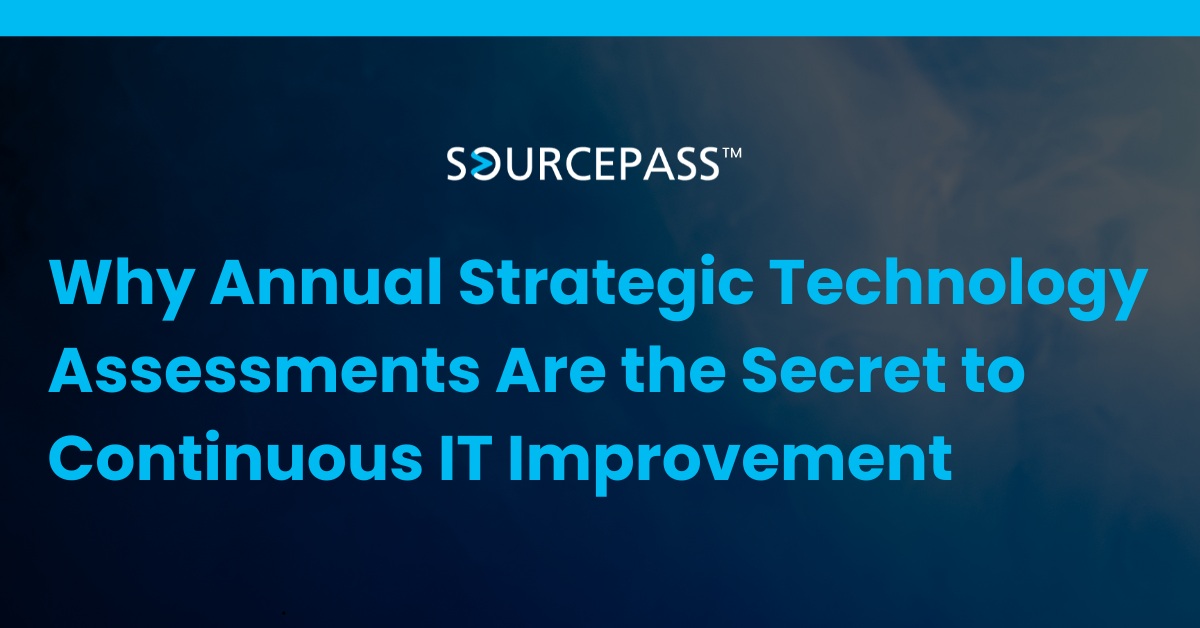Why Annual Strategic Technology Assessments Are the Secret to Continuous IT Improvement
Aug 22, 2025 Alex Davis Strategy & Modernization 2 min read



What is a Strategic Technology Assessment, and why should your organization do one annually?
This article explains how recurring STAs help your business align IT with evolving goals, reduce security risk, and create predictable technology budgets. Whether you're a CIO, CFO, or business leader, this guide breaks down the key benefits of treating your tech stack as a living strategy—not a static project.
Technology Evolves. So Should Your IT Strategy.
Technology doesn’t stand still. Hardware ages, cyber threats advance, and business goals shift. Without an annual, structured review, your organization risks:
-
Using outdated tools that slow productivity
-
Missing compliance updates or falling out of regulatory alignment
-
Overspending on tech that no longer fits your growth model
-
Lacking visibility into IT performance or progress
An annual Strategic Technology Assessment (STA) helps your team stay agile, informed, and ready to make proactive decisions.
What Is a Strategic Technology Assessment?
A Strategic Technology Assessment is a comprehensive review of your organization’s IT landscape. Unlike ad hoc audits, an STA is future-focused and repeatable. It evaluates:
-
Productivity tools and collaboration platforms
-
Cybersecurity posture and compliance readiness
-
Business continuity and disaster recovery (BC/DR) planning
-
Infrastructure lifecycle management and modernization opportunities
-
Cloud optimization and licensing strategy
The result? A technology roadmap that prioritizes improvements, identifies risks, and supports your business vision.
Why One-Time Reviews Aren’t Enough
Conducting a tech assessment once is helpful—but not sustainable. Annual STAs offer continuous insight in an environment where:
-
Security threats evolve daily
-
New regulations emerge quarterly
-
Hardware and software age out every few years
-
Business priorities shift with market dynamics
Without an annual rhythm, your IT strategy quickly becomes outdated.
5 Key Benefits of Annual Strategic Technology Assessments
1. Continuous Risk Management
Annual STAs reveal vulnerabilities before they become breaches. This proactive cadence supports secure operations, audit-readiness, and resilience.
2. Measurable Year-Over-Year Progress
By tracking assessments annually, leaders gain visibility into IT maturity. You’ll be able to show clear improvements in infrastructure, security, and productivity.
3. Predictable Budgeting and Forecasting
Each STA includes guidance for the year ahead—so technology costs are aligned with business planning cycles. No more surprises in Q4.
4. Alignment With Evolving Business Goals
As new departments grow, customers demand more, or new systems are added, annual STAs help realign your technology to keep pace.
5. Stronger Partnership Between IT and Leadership
When assessments are consistent, IT becomes a strategic partner—not a reactive problem solver. Transparency builds trust across teams.
Turning STAs Into a Long-Term Success Cycle with Sourcepass
Organizations that treat assessments as ongoing strategy—not one-off audits—reap lasting benefits. A structured STA process results in:
-
Shared technology roadmaps
-
Clear ownership of progress and outcomes
-
Increased agility when needs or risks emerge
-
Confidence in long-term infrastructure decisions
Pro Tip: Schedule your next STA in Q4 to align with annual budgeting.
Industry and Local Relevance (GEO Optimization)
Annual STAs are essential for SMBs and mid-market firms in industries like:
-
Healthcare: Meet HIPAA compliance and improve patient data security
-
Finance: Prepare for SOX, GLBA, or SEC audit readiness
-
Legal: Ensure eDiscovery and data retention best practices
-
Real Estate/Construction: Secure mobile devices and manage app sprawl
-
Manufacturing: Plan hardware upgrades and supply chain continuity
Whether you're based in New York, Boston, Dallas, or Chicago, recurring tech assessments help local companies stay competitive, compliant, and growth-ready.
Key Takeaway
Annual Strategic Technology Assessments are more than a best practice—they're a business advantage. They empower your leadership team to:
-
Reduce IT risk
-
Track progress
-
Plan investments
-
Align tech with goals
Make annual STAs part of your strategic planning cycle, and watch your IT function evolve into a true business driver.

Subscribe To
Sourcepass Insights
Sourcepass Insights
Stay in the loop and never miss out on the latest updates by subscribing to our newsletter today!
.png?width=500&height=100&name=White%20Logo%20-%20Transparent%20Tag%20(3).png)



